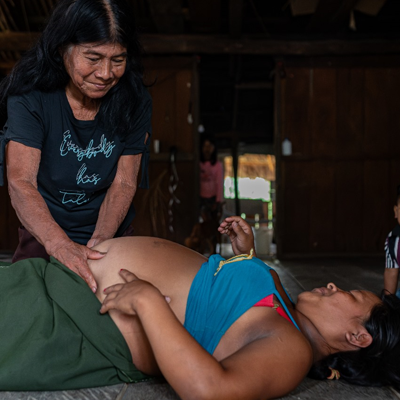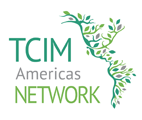Traditional Midwifery

In most indigenous, Afro-descendant, and Romani communities in the Americas, there are individuals (usually women) known as traditional birth attendants, midwives, or doulas (sobadoras or comadronas) who provide support, care, and advice to women during pregnancy, labor, and postpartum, as well as taking measures to prevent and detect complications in the mother and newborn (1). This role is based on ancient knowledge passed down from generation to generation to women and is part of the traditional model of health care (2).
In 1979, the World Health Organization defined a traditional birth attendant (TBA) as “a person (usually a woman) who assists the mother during childbirth and who initially acquired her skills by attending births herself or working with other traditional birth attendants” (3). Subsequently, in a joint statement with UNFPA and UNICEF in 1993, it defined a traditional midwife as a person who assists mothers during childbirth and who has acquired her initial knowledge of midwifery either on her own or by learning from other traditional midwives (4).
Furthermore, the WHO has promoted closer ties between institutions and traditional midwives as a strategy to reduce maternal and perinatal mortality among populations considered vulnerable, such as the ethnic peoples of the Americas (5).
Some of the countries in the region have begun to recognize and value, from an institutional standpoint, the importance of traditional midwifery and the work that midwives do as part of traditional medicine.
In Bolivia, the Ministry of Health and Sports grants licenses to midwives, who traditionally care for women’s health during pregnancy, childbirth, and the postpartum period, so that they can work as providers of traditional medicine services within the Unified Health System (SUS) (6). https://youtu.be/NMTa6AAKO6g
In Colombia, the knowledge associated with Afro midwifery in the Colombian Pacific region (Midwifery, ancestral knowledge, and living practice | The Cultural Network of the Bank of the Republic (banrepcultural.org)) was included in 2016 by the Ministry of Culture in the Representative List of Intangible Cultural Heritage, as a measure to safeguard and strengthen the knowledge and techniques possessed by traditional midwives (of African descent, indigenous, and peasant) in this area of the country (7). Resolution 1077 of April 25, 2017, issued by the Ministry of Culture, establishes that the knowledge of these midwives includes knowledge and techniques associated with body care and the use of medicinal plants to attend to women’s reproductive cycles, diagnose and treat illnesses; knowledge acquired through daily observation and experimentation and considered part of a traditional medical system that is passed down from generation to generation (8).
In Ecuador, there is a methodology for the cultural adaptation of childbirth care, where traditional midwives or comadronas are the facilitators of these processes. To participate in the care of women during childbirth in health institutions, they must be certified (accredited) to do so (9).
In Guatemala, midwives are called comadronas and are responsible for caring for women during their pregnancies for diagnosis, prognosis, childbirth and postpartum care, as well as for illnesses affecting women and children up to 9 months of age, and in some cases up to three years of age. “In preventive health, they provide counselling to the whole family on women’s health, child care and education, good family relationships, and especially good couple relationships. They advise on how many children a family should have and on the family’s diet, especially that of children and pregnant women” (10).
In Mexico, traditional midwives are recognized by the regulatory framework and are considered community health agents who are part of traditional indigenous medicine and care for women during pregnancy, childbirth, and the postpartum period, as well as newborns (11). Work is underway on a National Agenda for the Defense and Promotion of Traditional Midwifery (12).
Despite these advances, a Regional Mapping of Organizations and Experiences of Traditional Indigenous Midwives in the Americas (https://bit.ly/ParteriaIndigenaMapaInicial) carried out in 2022 by the Center for Indigenous Cultures of Peru – CHIRAPAQ, it was found that in many countries, health services still do not encourage traditional midwives to provide childbirth care. On the contrary, their knowledge is not recognized, their work is criminalized, or they are persecuted for providing their services at home, forcing them to become certified in programs for medicalized childbirth care in hospitals. This has led to a reduction in the care provided by traditional midwives and a gradual loss of their knowledge, which has put the continuity of the practice in crisis, as new generations are not acquiring this knowledge (12).
Nevertheless, the study shows that there has been a rapprochement between traditional midwifery organizations and the health systems of the countries in the region, leading to processes of visibility and promotion of the work of midwives. In the case of Brazil, midwives have managed to organize themselves at the national level, with the “National Midwives’ Meeting” promoted by Cais do Parto, which has been held every two years since 1996. In Guatemala, there is the Nim Alaxik National Movement of Grandmother Midwives, which coordinates the 22 departments of the country and has 22,100 associated midwives (12).
References
- Departamento Administrativo Nacional de Estadística (National Administrative Department of Statistics, DANE) and United Nations Population Fund (UNFPA). Traditional Midwifery and its incorporation into Colombia’s vital statistics. Statistical Note No. 3 of 2023. 58 pp.
https://colombia.unfpa.org/es/publications/analisis-de-parteria-tradicional-y-su-incorporacion-en-estadisticas-vitales - Almaguer González, José Alejandro, Vargas Vite, Vicente, and García Ramírez, Hernán José García. Interculturality in health. Experiences and contributions to the strengthening of health services. [Internet]. 2014. Editorial Program of the Government of the Republic; 3rd ed. Available at: https://pesquisa.bvsalud.org/portal/resource/pt/biblio-968759?lang=es.
- World Health Organization WHO. Traditional birth attendants: A practical guide for the training, assessment, and articulation of this personnel in health services 1979. Offset publications No. 44, 109 pp. http://9243700448-spa.pdf;sequence=1 (who.int)
- World Health Organization WHO Traditional Midwives. Joint WHO/UNFPA/UNICEF Statement, 1993. Available at: http://Parteras tradicionales : declaración conjunta OMS/FNUAP/UNICEF (who.int)
- García Ana Julieth, Cortina Navarro Carolina, Pabón Varela Yadira, Brito Ferreira Karen Daniela, and Freyle Brito Yeraldin Loresmi. Traditional midwifery. 2018. (Internet) Cuban Nursing Journal. 34(2):384-393. Available at: CLINICAL AND PATHOLOGICAL SCIENCES (sld.cu)
- Gonzales Liendo, Mary O. Traditional midwives as part of Bolivia’s intercultural public health system. Research. Bolivia, 2010. 92 pp. Available at: http://las-parteras-tradicionales-como-parte-del-sistema-de-salud-publ_DSp30Dl.pdf (bvsalud.org)
- Ministerio de Cultura. Lista Representativa de Patrimonio Cultural Inmaterial. Available at: https://www.mincultura.gov.co/areas/patrimonio/patrimonio-cultural-en-Colombia/Documents/LRPCI%20ACTUALIZADA%202022.pdf
- Ministerio de Cultura. Resolución 1077 de 2017. Available at: https://www.mincultura.gov.co/prensa/noticias/Documents/Patrimonio/20-Parter%C3%ADa%20afro%20del%20Pac%C3%ADfico%20-%20Resoluci%C3%B3n.pdf
- Villanueva Hernández, Ollinca I. and Freyermuth Enciso, Graciela. Traditional midwifery in the regulatory framework of four Latin American countries: from recognition to ambiguity.In: Midwifery in Latin America. Different territories, same battles/ Georgina Sánchez Ramírez and Hanna Laako, editors. [Internet] 2018. El Colegio de la Frontera Sur. First edition in electronic format, pp. 215-238. Available at: https://www.academia.edu/37727952/PARTER%C3%8DA_TRADICIONAL_EN_EL_MARCO_NORMATIVO_DE_CUATRO_PA%C3%8DSES_LATINOAMERICANOS_DEL_RECONOCIMIENTO_A_LA_AMBIG%C3%9CEDAD
- Ministerio de Salud Pública y Asistencia Social, Dirección General de Regulación Vigilancia y Control de la Salud, Departamento de Regulación de los Programas de Atención a las Personas, Programa de Medicina Tradicional y Alternativa. Manual de adecuación cultural del parto natural/vertical y sus distintas posiciones, en el marco multicultural de Guatemala. 2011. Available at: https://www3.paho.org/gut/dmdocuments/2011%20MANUAL%20DE%20ADECUACION%20CULTURAL%20DEL%20PARTO%20NATURAL%20VERTICALversion%20modificada%2024%20enero.pdf
- Ministerio de Salud. Guía para la autorización de las parteras tradicionales como personal de salud no profesional. Available at: https://www.gob.mx/cms/uploads/attachment/file/38480/GuiaAutorizacionParteras.pdf
- Centro de Investigaciones y Estudios Superiores en Antropología Social (CIESAS). Journal focused on topics in anthropology, social sciences, and humanities, Ichan Tecolotl, year 35, number 375, September 2023. ISSN 2683-314X. Mexico. Available at: https://ichan.ciesas.edu.mx/una-experiencia-de-mapeo-de-la-parteria-tradicional-indigena-en-las-americas/.


